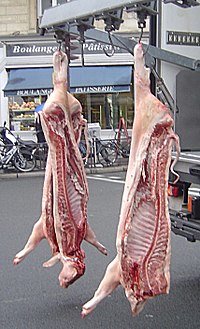This article needs additional citations for verification. (October 2012) |

Dressed weight (also known as dead weight or carcass weight) refers to the weight of an animal after being partially butchered, removing all the internal organs and often the head as well as inedible (or less desirable) portions of the tail and legs. It includes the bones, cartilage and other body structure still attached after this initial butchering. It is usually a fraction of the total weight of the animal, and an average of 59% of the original weight for cattle.[1] There is no singular way to dress an animal, as what is removed depends on whether it will be cooked whole or butchered further for sale of individual parts. For pigs, the dressed weight typically includes the skin, while most other ungulates are typically dressed without. For fowl, it is calculated with skin but without feathers. It can be expressed as a percentage of the animal's live weight, when it is known as the killing out percentage.
- ^ "Dressing Percentage of Slaughter Cattle". The Beef Site. November 22, 2006. Retrieved October 8, 2012.